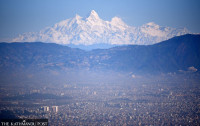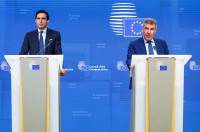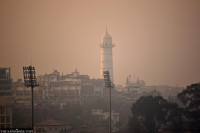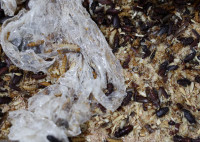Climate & Environment
Forests echo with summer migratory birds’ calls
Birds travel thousands of miles to Nepal, mainly to breed. Asian koel flies 6,000 miles from Sub-Saharan Africa.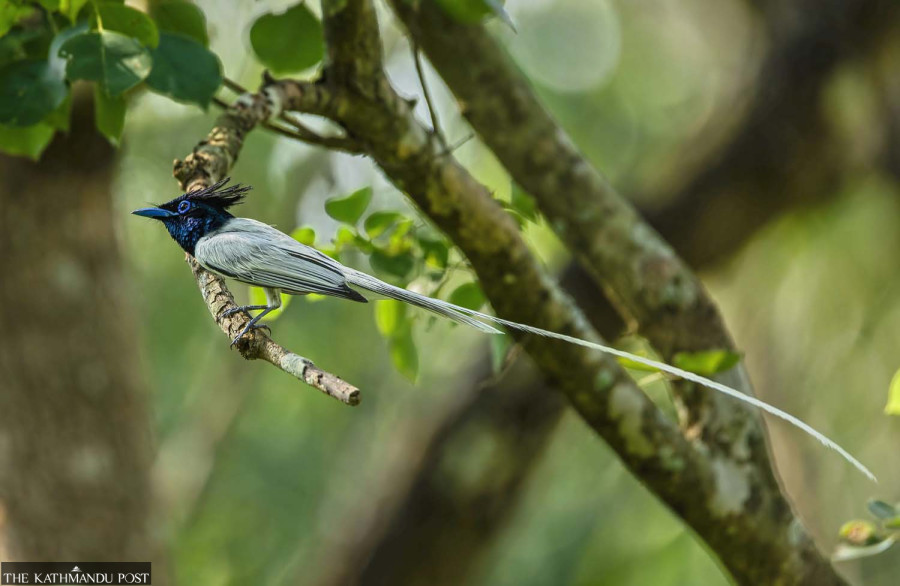
Manoj Paudel
The banks of Danav River along the Bhairahawa-Taulihawa road stretch in Rupandehi district are abuzz with activity as migratory birds arrive to nest. Among them, Chestnut-headed bee-eaters, locally called Katustauke muralichara, are seen digging holes on elevated ground to build their nests.
Similarly, the enchanting Indian paradise-flycatchers, locally named Swargachari, have made their way to the northeastern parts of Tilaurakot Collaborative Forest in Kapilvastu district. The Indian paradise-flycatchers are apparently searching for safer nesting grounds.
These summer migratory birds travel thousands of miles to Nepal, primarily to breed and raise their fledglings. According to senior ornithologist Hem Sagar Baral, the chestnut-headed bee-eaters first arrived in Chitwan through Dharan around mid-January from Southeast Asia, choosing nesting sites suitable for their needs. A month later, in mid-February, the Indian paradise-flycatchers arrived from northeastern India.
By now, many summer migratory birds have arrived in Nepal, covering vast distances. They are actively searching for safe nesting grounds. “These birds look for areas with adequate foliage and nesting materials. If they find a secure place with ample food, they start nesting immediately,” says ornithologist Hathan Chaudhary.
According to him, one such visitor, the blue-tailed bee-eater, has traveled approximately 1,680 miles from Thailand and is now in the community forests of Kawasoti in Nawalpur district.
Several bird species migrate to Nepal every summer as the country has favourable climatic conditions, food availability and safe environment for raising fledglings. The summer migratory birds start arriving in Nepal from mid-January and stay for a few months.
Ornithologists say that around 60 species of birds migrate to Nepal each summer. Most of the summer migratory birds come to lay eggs, hatch them and raise their young. According to Baral, nearly 57-58 species have already arrived in Nepal. The only exception is the Asian koel (a large and long-tailed cuckoo), which has yet to arrive.
The Asian koel travels over 6,000 miles from Sub-Saharan Africa, passing through Ethiopia, Somalia, and Yemen before crossing the Arabian Sea. According to ornithologist DB Chaudhary, the koel rides the pre-monsoon winds from the Arabian Sea and usually reaches Nepal by late May.
Other summer migratory birds, including the Indian golden oriole, the orange-headed thrush, and the black-naped monarch have already been spotted in Chitwan National Park and forest areas in Lumbini.
Birds such as the western hooded pitta, the Indian pitta, Indian cuckoo and the oriental dollarbird are actively scouting nesting sites. These summer visitors first assess the local environment, ensuring it is suitable for raising their young.

In Nepal, these birds make their nests on trees in forests, along riverbanks, and even in agricultural fields. As spring sets in, birds from India, Sri Lanka, Thailand, Cambodia, Laos, Myanmar, Malaysia and Indonesia arrive after a journey of four to ten days. They breed and nurture their chicks here before migrating back to their original habitats. Many cross into Nepal from Myanmar and Bangladesh via the Bay of Bengal.
One white-throated needletail, as ornithologists inform, came all the way from Australia. Among the 60 migratory species that come to Nepal, all except the white-throated needletail primarily arrive for breeding.
The forests are now lively with new sprouts and the melodies of birds. It takes about three weeks for birds to build their nests. While winter migrants return to the north, summer migratory birds arrive from the south. Of Nepal’s 19 koel species, 13 practise brood parasitism. They watch other birds build their nests, and once the nests are ready, lay their own eggs in them.
“By mid-May, most of these birds will have completed their nests. By late July, their chicks will be ready to fledge,” says ornithologist Tulsi Subedi. Larger birds take longer to raise their young compared to smaller ones. As Nepal currently has longer daylight hours than night, birds have ample time to forage, making the country an attractive breeding ground.
Chitwan, Bardiya, Shuklaphanta, Parsa, Shivapuri and Banke national parks host thousands of nesting birds each summer. Moreover, Koshi Tappu, Manohara and the Annapurna Conservation Area have also become major breeding sites along with some community forests.
While most birds nest in the Tarai, some settle in the mid-hills and a few species even build nests in the high Himalayas. These birds will remain in Nepal until September or October before migrating back.
With the Purple-backed sunbird, known in Nepali as Baijani Dhade Bungechara, spotted in Kankadbhitta of Jhapa by bird enthusiast Devendra Kharel on February 19, the total number of bird species recorded in Nepal has now reached 898.




 8.12°C Kathmandu
8.12°C Kathmandu
